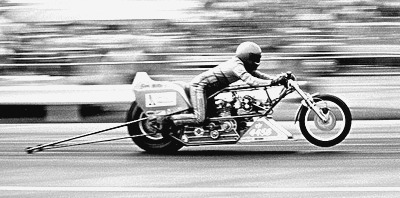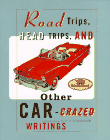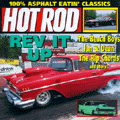|
|
 |
|
||||
|
|
||||||
|
For a couple of years, AMDRA and NHRA ran fuel motorcycles and they captured the fancy of the fans. However, AMDRA's involvement with NHRA dissolved to nothing and by 1977 were totally absent from the scene. Despite the fact that AMDRA had dissolved, NHRA didn't totally abandon the bikes, running them at a few national events. In the 1970s, established stars like Smith (1974 and '75 U.S. Nationals winner) and Christensen (1972 and '73 Supernationals winner) won events and set records and were joined by star racers of the middle and late 1970s like Mauriello on Sonny Routt's Triumph, Marion Owens, Joe Thronson, Larry Welch, Danny Johnson, Jim Bernard on Ron Teson's blown Yamaha single, and the most distinctive of all, Russ Collins' "Atchison, Topeka, and Santa Fe" triple motor '74 Yamaha, which ran an unheard of speed of 199.54-mph at the '78 Supernationals.
A major part of the reason NHRA hung with the bikes were two of the most fabled names in motorcycle racing: Terry Vance and Byron Hines. Vance, who won 28 NHRA national event trophies in his career, and his partner secured sponsorship for their Pro Stock Suzuki from the Suzuki Corporation. In fact, if you wanted to single out the one team that was most responsible for putting the Japanese bikes into drag racing it was these two. Harris, who had run the AMDRA shows, created NMRA and became an affiliate with NHRA in 1980. This involvement, along with the fact that for the past two years Suzuki had been the official motorcycle of the NHRA, dovetailed nicely and indicated that the fuel bikes might become a permanent part of drag racing consciousness. In 1980, possibly the single best pass by any type of vehicle was made by a fuel motorcycle. Florida's Bo O'Brochta, that year's NMRA Top Fuel champion, bettered the previous best of 7.28 with an absolutely mind-blowing 7.08 on his Terminal Van Lines blown Kawasaki, while winning the NHRA Supernationals World Finals. The following year, NHRA and NMRA booked another ambitious schedule of 12 races, with the Southern Nationals, U.S. Nationals, and Winston World Finals featuring Top Fuel exclusively. (The other nine ranged from national events hosting Funny Bike and Pro Stock to all-bike confabs.) |
|
|||||
|
|
||||||

Copyright 1999-2001, Drag Racing Online and Racing Net Source |
||||||







